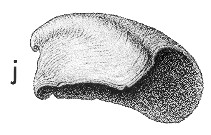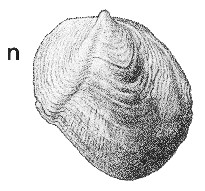
Revised descriptions of New Zealand Cenozoic Mollusca from Beu and Maxwell (1990)

 | Revised descriptions of New Zealand Cenozoic Mollusca from Beu and Maxwell (1990) | 
|
  (Pl. 47j): Landguard Sand, Landguard Bluff, Wanganui, Haweran (oxygen isotope stage 9) (GNS, ex Suter Collection) |
  (Pl. 47n): Landguard Sand, Landguard Bluff, Wanganui, Haweran (oxygen isotope stage 9) (GNS, ex Suter Collection) |
Beu & Maxwell (1990): Chapter 16; p. 348; pl. 47 j, n.
Synonymy: Pileopsis danieli Crosse 1858, p. 81; Pilaeopsis uncinatus Hutton 1873b, p. 14; Capulus australis (Lamarck) of Suter 1914, p. 19 (not of Lamarck); Hipponyx uncinatus; Capulus uncinatus, Beu & Maxwell 1990, p. 348, pl. 47j, n; see Beu (2006, p. 193) for detailed synonymy.
Classification: Capulidae
Description: Large for genus (20-30 mm in diameter), low and limpet-shaped, with protoconch of 1.3 smooth planispiral whorls, followed by a simple, cap-shaped, rapidly expanding teleoconch of less than 1 whorl, smooth inside except for a large horseshoe-shaped muscle scar. Apex overhangs posterior end; posterior slope concave, anterior slope strongly convex. Exterior bears many very fine, close radial costellae, crossed by prominent, irregular growth ridges; most specimens with large anterior sulcus in margin, generating a high, wide, rounded radial fold occupying a third of shell width, and with several narrow, deep, posterior sulci in margin that generate prominent narrow radial folds.
Comparison: Capulus danieli specimens found in New Zealand lived attached to Pecten novaezelandiae shells at the junction of an ear with the umbo, on the right (inflated) valve (Dell 1964) and show xenomorphic sculpture (reflecting that of its host) in the form of a wide, deep sulcus in the margin (fitting the Pecten ear) that generates a prominent, low, wide radial fold, between its narrow anterior projection and the shell apex; several smaller sulci and projections around the posterior end (below the protoconch) of most specimens fit the interspaces between the Pecten costae. In most specimens, the wide sulcus is on the right side of the anterior margin (the shell lived on the anterior Pecten ear) but it is on the left side of a few (the Capulus lived on the posterior Pecten ear).
Suter (1914, p. 19) thought Capulus uncinatus the same species as the living southern Australian C. australis (Lamarck), and a new comparison of shells has shown no differences from specimens in Suter's collection labelled as C. australis. However, this name applies to a southern Australian species of Sabia (Hipponicidae); Suter's specimens are wrongly identified (pers. comm. W.F. Ponder, Australian Museum). However, Beu (2004, pp. 192-200) showed that Suter was correct to recognise this species as identical with Australian shells, as the New Zealand specimene are identical to Capulus danieli, which lives on pectinoidean shells (Pecten, Glorichlamys, Amusium, and Spondylus) throughout the tropical western Pacific at present, from southern Japan to South Australia. This is one of several species identified by Beu (2004, 2006, 2009) as extending their ranges to New Zealand as planktotrophic larvae during warm interglacial periods of Nukumaruan-Haweran time. C. uncinatus is not closely related to the living southern deep-water species C. novaezelandiae Dell (1978, p. 164).
Distribution: Haweran; Landguard Sand, Landguard Bluff, east of mouth of Wanganui River (type), very rare (oxygen isotope stage 9); Te Piki, Cape Runaway, near East Cape, Haweran (oxygen isotope stage 7), not uncommon attached to Pecten shells.
Cite this publication as: "A.G. Beu and J.I. Raine (2009). Revised
descriptions of New Zealand Cenozoic Mollusca from Beu and Maxwell (1990). GNS
Science miscellaneous series no. 27."
© GNS Science, 2009
ISBN
978-0-478-19705-1
ISSN 1177-2441
(Included with a PDF facsimile file
copy of New Zealand Geological Survey Paleontological Bulletin 58 in CD version
from: Publications Officer, GNS Science, P.O. Box 30368 Lower Hutt, New
Zealand)